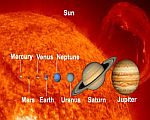- Home
- Subatomic Particles
- Quarks
Quarks - one of the two types of particle that constitute matter
Quarks are a type of "elementary" subatomic particle, meaning they cannot be subdivided any further. There are six different types, or "flavours".
They come in pairs, known as "generations" with each subsequent one having greater mass. So, we have the "up", paired with the "down", the "charm" and "strange" and the "top" and "bottom". If you think these names are a touch random, then let me try and explain.
The up and down pair were named so after the so-called "isospin" they carry. This is a quantum property and attempting to explain what that is would take us into the realm of advanced physics...so let's not, eh? Top and bottom were named as "logical partners to up and down". But, it's the charm and strange that are the most intriguing.
"Charm" was chosen because this particular quark brought "symmetry to the subnuclear world". "Strange" came from the fact that these particular quarks were components of "strange particles" found in cosmic rays.
Electromagnetic Charge
All subatomic particles must have an electromagnetic charge and its value has to be a whole number. By far the most common values are -1, 0 and 1. These are the charges displayed by the electron, neutron and proton respectively.
Now, things begin to get a bit involved when the electromagnetic charges of the different quarks are considered. The three "up" ones - up, charm and top - have a charge of 2/3, while the "down" ones - down, strange and bottom - have one of -1/3. So, as you can see, to arrive at a charge that is a whole number, the quarks have to be in combinations. You could thus have a group of three consisting of two up and one down, where the collective charges would be 2/3+2/3-1/3=1. This then manifests as a proton. You could also have one up and two down: 2/3-1/3-1/3=0 and this would be a neutron.
All particles made up of quarks are collectively known as hadrons. When three are involved, as just explained, the resultant particles are called baryons.
Mesons
"Mesons" is the collective name for particles that consist of only two quarks. Hang on, you mathematicians out there may be thinking, how can you arrive at a whole number with the values of charge available using only two of them? It's not possible!
Well, the way this works is to bring in the "antiquark". It is thought that all particles have their anti- counterparts with the opposite electromagnetic charge. So, if you took an up quark and a down antiquark, the collective charge would be 2/3+1/3=1. Such a meson is called a pion.
Paradoxically, mesons are considered composite bosons, rather than fermions. Don't ask me why. |
The Neutron Problem
Regarding antiparticles, the more perceptive amongst you may have been thinking, if they have an opposite charge to their normal counterparts, what about the neutron, which has zero charge? Surely the antineutron would be identical to the neutron.
Well, its already been said that a neutron reaches its zero charge value by combining one up quark and two down ones (2/3-1/3-1/3=0). Quite simply, the antineutron uses a different combination of one up antiquark and two down antiquarks (-2/3+1/3+1/3=0).
The Even Bigger Neutrino Problem
The neutron/antineutron conundrum can be explained away as above. But neutrons are composite particles. What about the neutrino, which also has zero charge and is an elementary particle? The antineutrino is known to exist, so what distinguishes it from its counterpart?
The short answer is...nothing! Both particles are, as far as physicists know, identical. Particles that are their own antiparticle are known as Majorama particles, after Italian theoretical physicist Ettore Majoram who hypothesized their existence in 1937.









Facebook Comments
Have your say about what you just read! Leave me a comment in the box below.